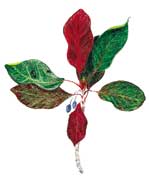 |
Earth Journal
by Gary Pendleton |
 The Blue Drupe and its Tupelo Tree
The Blue Drupe and its Tupelo Tree
Water Nymph of the Woods reveals its noble nature each October
Nyssa sylvatica is the scientific name for a medium-size tree common to wet areas of the eastern U.S. The name means water nymph of the woods. It also has a bunch of common names.
Some call the tree black gum even though, according to naturalist and author Donald Culross Peattie, this “dry and disobliging vegetable” has never produced an ounce of gum-like fluid. Some have called it Pepperidge, a pleasant name but one that also carries no obvious etymology. The name that it is best known by, and its most melodious appellation, is tupelo. That name comes from the language of the Creek tribe of northern Georgia; it means swamp tree.
Befitting such a musical sound, tupelo has a couple of notable musical associations, one accidental the other intentional. Tupelo, Mississippi, is the birthplace of Elvis Presley. “Tupelo Honey” is the title of a popular song.
Tupelo honey is also a delicately flavored, lightly colored honey produced by bees that have visited the flowers of the cousin Nyssa ogeche, the white tupelo that grows in Florida.
Tupelo has limited commercial value. Boards made from it warp and shrink. Because it is a wetland tree one would think it resists rot, but the opposite is true. The tupelo’s wood fibers are inter-braided, making it impossible to split, and this quality makes it a reasonable choice for some heavy-duty uses. It has been used for tool handles, chopping boards and factory flooring.
Oaks have acorns, hickories and walnuts produce nuts, maples make those wing-shaped seeds. The tupelo’s fruit is something you have probably never heard of before. Unless that is, you are a botanist or an avid crossword puzzle fan. The fruit of the tupelo is a drupe, a blue drupe. A drupe is similar to a berry. It is a single seed enclosed in a fleshy covering. A real berry such as a blueberry (and not a strawberry) has multiple seeds dispersed throughout the flesh.
The fall color of the tupelo tree was described by Peattie as “gorgeous deep Burgundy.” The bark is furrowed and checked like alligator skin. Before turning color, the thick leaves are dark green and glossy, almost like the evergreen leaves of holly and rhododendron.
Nyssa sylvatica, water nymph of the woods, also known as tupelo, is an unimposing and humble tree that reveals it noble nature for a brief period every October.
